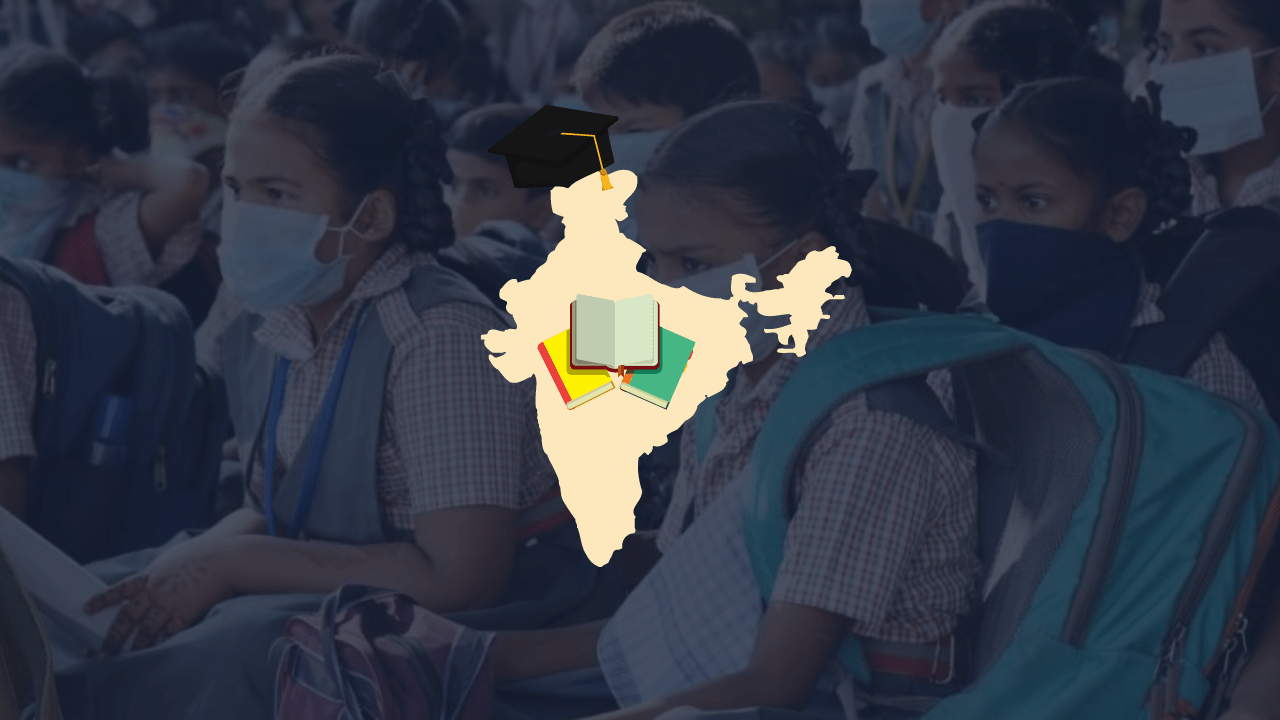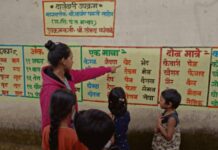This week marks sixteen months since schools and colleges across India shut down as the COVID-19 pandemic spread across the world. In these months, India’s children have seen their schools and classrooms disappear from view; for the younger ones, they have probably disappeared from their memory altogether, as impressions of their teachers and schoolmates fade into oblivion. Many students who were fortunate enough to have access to technology have had to make do with online learning, while those less fortunate have forgotten much of what they learnt. Across the country, teachers are stretched thin and burnt out from the stress of adapting to new teaching pedagogies online while juggling their own household responsibilities.
As India recovers from the brutal second COVID-19 wave and prepares for future surges, parents, students, and school administrators are worried about the prospect of losing a second academic year to the pandemic, and rightly so. In response, several state governments like Haryana, Telangana, Gujarat, and Punjab have declared that schools may reopen (following specific schedules, formats) for certain classes by the end of July or in early August 2021.
Straight off the bat, this focus on reopening schools is much needed and welcome. There is widespread evidence on three mutually reinforcing reasons for this need.
First, evidence from India and across the world shows that children appear to be more resilient against COVID-19. Global evidence suggests low susceptibility and infectiousness among children. Emerging studies are showing that susceptibility to COVID-19 increases with age, with much lower infection rates in children under the age of 10 years. Of course, we will need to continue to track paediatric incidence, especially in the context of new variants. But as things stand, the evidence seems to indicate that children are not affected by the virus in the same way as adults.
Second, there is little evidence that opening schools in other parts of the world like Germany and South Africa have substantially fueled community transmission rates. Indeed, the spread of COVID-19 in schools mirrors that of society at large. When cases are low within communities, schools reflect those low rates. Strategically, such times are the best moments to open schools.
Third, there is rapidly growing evidence on the costs of keeping children — especially young ones below the age of 8 years — out of school. These costs broadly fall into three categories: learning losses, or the loss of learning competencies from missing regular classes; social, emotional, and mental health challenges that arise from the stress of the pandemic and the absence of regular contact with peer groups and social networks; and growing inequities between those with access to technology for remote learning, and those without. This is besides the millions of children who are dependent on the Mid-day Meal Scheme for meeting their basic nutritional requirements.
The decision to open schools needs to be part of an overall risk mitigation strategy that considers the relative costs and benefits of opening different sectors of the Indian economy. Most states have prioritized those sectors that are deemed ‘critical’ to the economy and for livelihoods; this has led to markets, malls, gyms, restaurants — places of trade and leisure — opening while school systems stay shut. But, what we are not seeing is that there are significant costs to keeping children out of school; it is just that these costs may not be just as immediately apparent or as easily economically quantifiable in the short run.
Studies from previous historical disasters wherein schools stayed shut for two years showed severe learning losses, which are often irreparable. Further, they showed a significant decline in the lifetime earning potential of children who lost those years in school.
The alternative to reopening schools physically is losing another academic year of schooling. In particular, this loss hurts the large and at-risk group of children that does not have access to remote learning that comprises first-generation learners who cannot rely on adults at home to teach them, and whose parents see education as the path out of poverty and deprivation. Irrespective of the income status of their family, the physical health and mental wellbeing of all children are at risk the longer they stay at home. As a society, we should be prioritizing their learning above most else. Yet, until recently, there has been a deafening silence on helping students return to school.
The crucial question to ask is not “should schools reopen now?”.
Instead, it should be “what are the conditions under which schools can reopen safely?”.
None of this is to say that schools can reopen overnight. During a pandemic, no government or education board can give a zero-risk assurance for staying clear of the virus. But, just as risk mitigation strategies are applied to other sectors that have reopened, there are ways of minimizing risk in the education sector. These measures require preparation, deliberation, and consultation, and would suffer from haste.
Existing evidence leads us towards four points of action. First, to consider reopening schools as part of an overall risk mitigation strategy based on epidemiological data on transmission, and then consider trade-offs between opening schools and other sectors of the local economy; second, to consult widely with teachers, principals, parents, and private school representatives to decide on a consensus-based set of safe actions; third, to act on a set of preparatory actions before bringing children in; and fourth, to make decisions to reopen in locally contextualized ways based on epidemiological trends at the community level.
Teachers in Nilamnagar in western India have set up outdoor classrooms for a total of 1,700 students.
Here a small group of students gathers around painted walls, which are used for teachings.https://t.co/SmlqUcFu3W
— WION (@WIONews) September 3, 2020
As schools begin to open, there are prerequisites that need to be in place to minimize the risk to students and teachers, and by extension, their families and communities. Following these will also reduce nervousness amongst parents who worry about exposing their children to the virus in schools. The Lancet COVID-19 Commission India Task Force has recommended a series of steps for schools to prepare for reopening.
The first step would be to expedite the vaccination of all teachers, school staff, and volunteers. We now have ample evidence that vaccination is key to protecting society, in terms of reduced transmission, less severe infections, and fewer hospitalizations. The caveat about breakthrough infections and new variants remains, but vaccinations still make it much safer to resume normal activity. Without double vaccinations for all adults that engage in schools, it will be difficult to convince parents that the school environment is safe. We do not see children’s vaccines being approved and deployed in time for the current academic year, although once there is demonstrated efficacy and safety in child vaccines, those will and should be rolled out as well.
The second step is to prepare the school premises themselves: ventilated classrooms and buses, a higher proportion of outdoor activities, masking, sanitation, and distancing through batching of students, especially in those schools with high densities and large-size classrooms. Many such guidelines have already been issued by the Ministry of Health and Family Welfare, as well as several state governments. A district-based exercise to ascertain compliance, bottlenecks, and costs should be undertaken urgently to support schools in planning for a COVID-19 safe opening.
The third step is to recognize that there will be episodic spikes in the pandemic moving forward. When these spikes are imminent, or if there is an outbreak within the school community, schools may well need to shut temporarily. Teachers will need to plan for such contingencies. Plans will need to include a focus on flexible learning modes, preparation for sudden switches to remote learning, investments in backup teaching staff, and a modular syllabus that can adapt to changing realities. In this situation, teaching to a rigid syllabus is neither realistic nor always right. Since many children will be returning to school after sixteen months at home, they will need time to acclimatize to a routine and get familiar with regular learning modes.
The fourth step for governing the reopening of educational institutions is to ensure barrier-free access to testing. While continuous or pooled testing is not recommended except at the start of the academic year, any symptomatic member of the school community should have access to RT-PCR testing, followed by similar tests for all close contacts. Schools should adhere to official guidelines on quarantines and isolation, in a bid to limit transmission to the immediate circle of contacts.
Amidst the strategic reopening of schools comes a question of prioritization: should all children return to school immediately?
Except in rural and hard-to-reach hamlets with a low incidence of the virus, a staggered approach to reopening classes may be better, especially wherever concerns around community transmission exist. At the very least, children under the age of 8 years, and those in their final year of schooling must be prioritized. Those between the ages of 8 and 15 years can return as teachers, parents, and principals gain confidence in the process.
In India, where the vast majority of the working poor pin their hopes on education to give their children a better future, the damage from continued school closures will be devastating now, and for generations to come. Both teachers and students will be returning to a world of classrooms that is very different from the one they left behind sixteen months back. Safety is paramount; physical safety of course, but also the emotional and psychological safety of our children. Bringing students back to a regular and familiar routine will require time, skill, and patience on everyone’s part. India’s principals and teachers will need additional training and support to create these safe environments, especially to coax our younger children into patterns of learning and socialization.
Common themes will abound — masking, minimal sharing, distancing and perhaps the batching of classes, with a greater emphasis on outdoor activities, including, where possible, outdoor classes. Detailed as they may be, these adjustments are worth making if they can allow for children to be back in their classrooms, doing what children are meant to do: learn, absorb, and play.






